There was probably not a single person, who has not got familiar with the news that Bitcoin market value just crossed USD 60,000 mark delivering the return over 100% for its investors, while total capitalisation exceeded USD 1 trillion. In fact, this rally just took couple of weeks during the first months of 2021, please refer to Chart at bottom of this article for details.(1) So, lets have a look on what really caused this market fever and if any of those factors could persist for a longer period. But, before we dig into the core of this topic, some introduction about the basic facts might be useful.
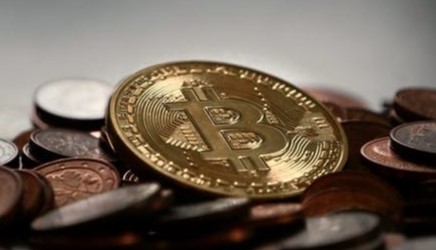
What is Bitcoin, at all?
The first Bitcoin (BTC) specification and concept description was published in 2009 in a cryptography mailing list by Satoshi Nakamoto (an acronym for unknown person), where he released version 0.1 of the bitcoin software on SourceForge, and launched the network by mining the genesis block of bitcoin (block number 0, refer to picture below). Embedded in the coinbase transaction of this block was the text: “The Times 03/Jan/2009 Chancellor on brink of second bailout for banks”, referring to a headline in the UK newspaper The Times published on that date. This note has been interpreted as both a timestamp of the genesis date and a comment on the instability caused by fractional-reserve banking.(2) Quite clearly, this was a demonstration of gaining some independency on current monetary system, while creating an independent digital currency, whereas any intermediary institution or central bank should be avoided. It was a result of post-financial crises period (post 2008 period), which revelead how the banks behaved with large piece of irresponsibility and were often labelled to be too much greedy, when chasing profits.
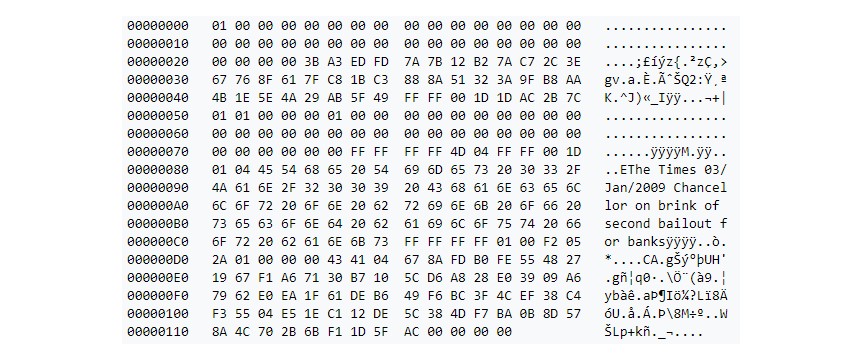
source: wikipedia.org
It was aimed to become a non-cash peer-to-peer payment network that is powered by its users with no central (bank) authority. The Bitcoin processing works based on open public protocol and the „double-spending“ from same account should be avoided via independent authorization of payment settlement based on mathematical algorithm. For a better imagination, Bitcoin is nothing more than a mobile app or computer program that provides a personal Bitcoin wallet and allows a users to send and receive bitcoins among them.
For instance, in retail business, the payments are designed to be sent just connecting two mobiles via NFC technology or QR codes, which made it quicker than using a credit cards, as the payment settlement takes only couple of hours, which is probably the most appealing aspect about using BTC.
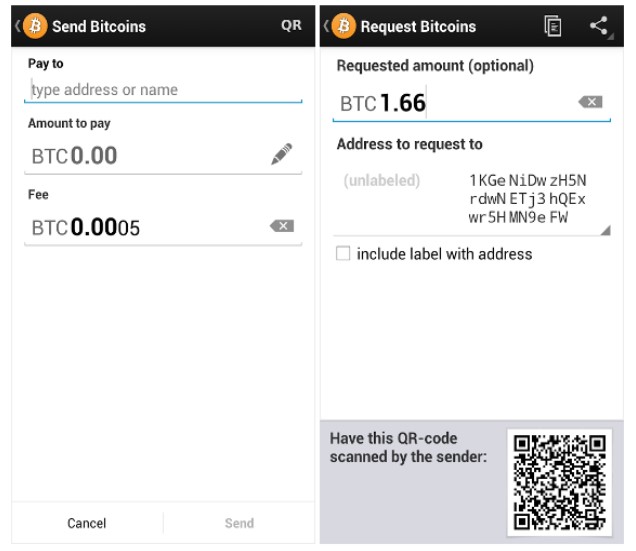
Behind the scenes, the Bitcoin network is sharing a public ledger called the “block chain”. This ledger contains every transaction that has been ever processed, allowing a user’s computer to verify the validity of each transaction. This process is called a „mining“, which refers to gaining some reward (fees) for running a code and thus veryfying settled transaction. Till today, there has not been any evidence that mathematical algorithm behind BTC processing would have failed or that payment was sent/received incorrectly. This has proved that Bitcoin was designed properly.
In general, Bitcoins can be purchased in following ways:
- When selling some goods or services for BTC – this kind of exchange was aimed mainly for retail business, however there have been also first attempts of large banks to settle the Documentary business products via Blockchain. For instance, ING Bank together with HSBC, among first banking institutions, conducted a Letter of Credit for agriculture Cargil Group blockchain transaction covering a soybean bulk shipment from Argentina through Geneva to Malaysia, in May 2018.(3) As a main advantage, was by client the time of whole transfer, which was completed within 48 hours instead of usual 5-10 working days. Nevertheless, it was not disclosed whether the payment was settled in Bitcoins or another regular currency (more likely). But, there is some limitation in that as only couple of global banks are using this Corda platform, so that only clients of these global banks can utilize it, so far. On the other hand, Asian countries are fastly adopting new payment platforms, which are working on same basis as blockchain, as they are promissing to be faster, safer and more transparent than other usual methods. Nowadays, there are estimated around 250,000 transactions processed in BTC on daily basis.
- Buying them on Stock-exchange – there are various trading platforms used world-wide (altogether more than 300!!), where crypto-currencies can be purchased. Among others, there are the leading ones like Coinbase, eToro, Binance, Gemini, Coinmama, Abra, DeCurret etc., which alow the investors to trade various cryptos besides BTC. Their main advantage is the high liquidity and providing digital wallet for their users to safely store purchased assets.(4) This is very critical and often very underestimated element, because unlike stocks or cash money, there are official banks statement conforming the BTC balance held with your wallet. There is just some digital key, which every user has been got and if this is lost, then your access to your Bitcoins is gone. This is clearly seen as the main benefit for investors, so that more than 56 million investors in more than 100 countries use Coinbase, accounting for $355 billion in quarterly trades and $90 billion in assets on the platform, according to the company’s website.(5) Riding on a positive way for cryptos-trading increasing volume, Coinbase decided for direct listing of its new shares on NASDAQ during the April 2021, whereas during the first trading day, initial market value of the company spiked up above $70 billion, which was pretty close to market capitalisation of ICE Intercontinental Exchange ($67 billion), but even higher than Chicago Board of Exchange, CBOE ($11 billion) or even NASDAQ ($26 billion)(6), which however deliver higher liquidity for market participants, settle higher volumes of trades and represent in some cases irreplacable trading venues for whole financial world. It will be very interesting to monitor further development of Coinbase, because if some worries about Bitcoin related bubbles were to be true then this title could provide very close guidance.
- Running a computer programme to encrypt the Block-chain algorithm and getting a reward for it (called as mining process). This requires powerful IT hardware and knowledge of computing algorithm to be among the fastest users to verify the transactions. Quite clearly, most miners are recruited among the IT professionals, which used to be claimed as very first BTC owners. However, this process is also energy-demanding and reward for mining is being regurarly cut by half every four years. High energy consumption during the mining is given by fact that Blockchain file contains all historical records that have been already processed so that it total size is continuously increasing, whereas in 2014 it reached 20 Gigabytes, resp. during 2017 it has further grown to 100 GB and by early 2020 total BTC Ledger size exceeded 200 GB.(7) That means this increasing size of blockchain record may represent technical problem for a future, as IT requirements for processing it will be more demanding and “mining” competition is increasing due to diminishing volume of available Bitcoins in free circulation.
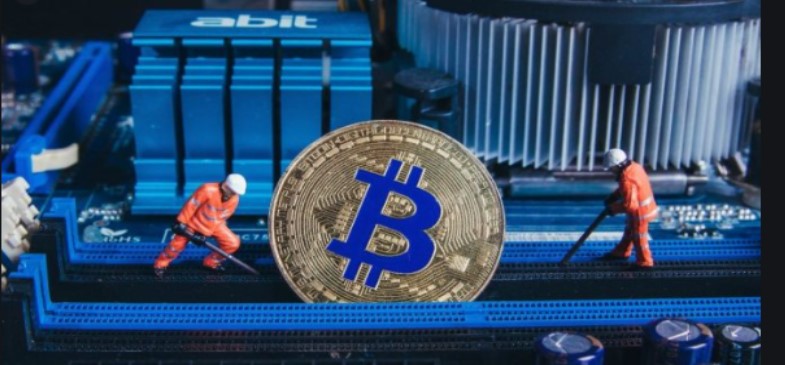
Could BTC become a new global currency?
Well, Bitcoin has certain characteristics of money (like durability, portability, divisibility, and recognizability) based on the properties of mathematics rather than relying on physical properties (like gold and silver) or trust in central authorities (like fiat currencies). However, it still rather seems to be an (highly speculative) investment asset class than any real alternative to any currency. Why is that so? Because of these following reasons:
- Bitcoins are created at a decreasing and predictable rate. The number of new bitcoins created each year is automatically halved over time until the moment when Bitcoin issuance halts completely with a total of 21 million bitcoins in existence (at moment there is around 18 million BTC units in circulation). Even the BTC founder, Mr. Nakamoto, in his early testament, admitted that BTC may totally run out and not new additional units will be generated (see below) (8). That is very unique compared to traditional currencies, whose total mass is rather increasing in line with economic growth (and connected demand for more money in circulation).
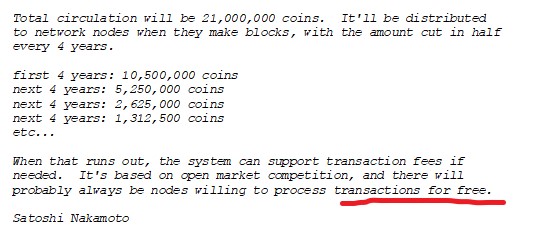
- There is increased volatility in BTC, which is hardly comparable with other currencies like US Dollar, Japanese Yen or EURO (traditional global currencies oscillate in reasonable band of +/- 15% p.a., while BTC itself can change its value by more than 50% within a month). In addition, there are mainly psychological reasons that drive Bitcoin up and down, on the contrast to it, global currencies evolution is influenced by economic factors like mutual trade balances, interest rates for deposits, domestic inflation in home market etc.
- There were until recently very limited hedging possibilities for future BTC value in place, which means that its users, investors and buyers were running highly speculative risk and no-one knew precisely whether a wallet full of one hundreed BTCs would be enough to buy an ice-cream, a van full of ice-cream or even an island, in twelve Months of time. On the other hand, if you have USD 100,000 on your bank account, you can be sure that it will be still enough to buy a small flat in Florida, even in one, two or three years time. As financial markets offer full spectrum of derivative/hedging products in FOREX area, also some trading venues (CME, Deribit, FTX etc.), started offering the Options and Forward trades for Bitcoins, and volumes are predicted to be growing with increased interest for Bitcoins, as well (however current daily ave.volumes around USD 5 billions lag behind traditional FOREX Derivatives volumes traded in regulated markets). For an overview of average daily volumes traded on CME, see attached Chart beneath this section.
- Each retailer as well as whole-sale businesses will need to run dual pricing list for their goods sold (i) under higher BTC market value fluctuation and in case of (ii) limited supply of available BTC. It means that with a current value of one BTC around USD 60,000 you may buy one personnal vehicle being worth of USD 60,000. But in case of frequently changing BTC value, the retailer would need to adjust the price for offered vehicle from initial one BTC to two BTC etc. Although that may appear as not a big issue, it may represent some excessive administrative agenda, even when sales in BTC will not be main flow of income, but rather a complementary one.
- There is no central authority having control over BTC, the settlement of payments goes through unknown private persons (miners) instead of some authorized clearing house and if there is some fraudulent activity on Blockchain spotted, there must be a majority (over 51%) miners consent to perform some reverse operation in Blockchain in order to correct the wrong record, therein.
- The energy consumption connected with mining process gets increasing, which makes the life for this crypto-currency more demanding and capital expenditure for processing it will be most likely rising. For instance, a BitRiver (key player in Russian crypto-currency mining market) aims to increase the capacity of its mining farms located in Siberia from current 150 megawatts to planned output of total 400 MW due to growing interest of miners from China, South Korea, Japan and Persian Gulf countries like Quatar, Saudi Arabia etc. These mining farms are data centers equipped with powerful servers, computers and network, where miners are allowed to rent some capacity and pay just regular maintenance fee for that.(9)
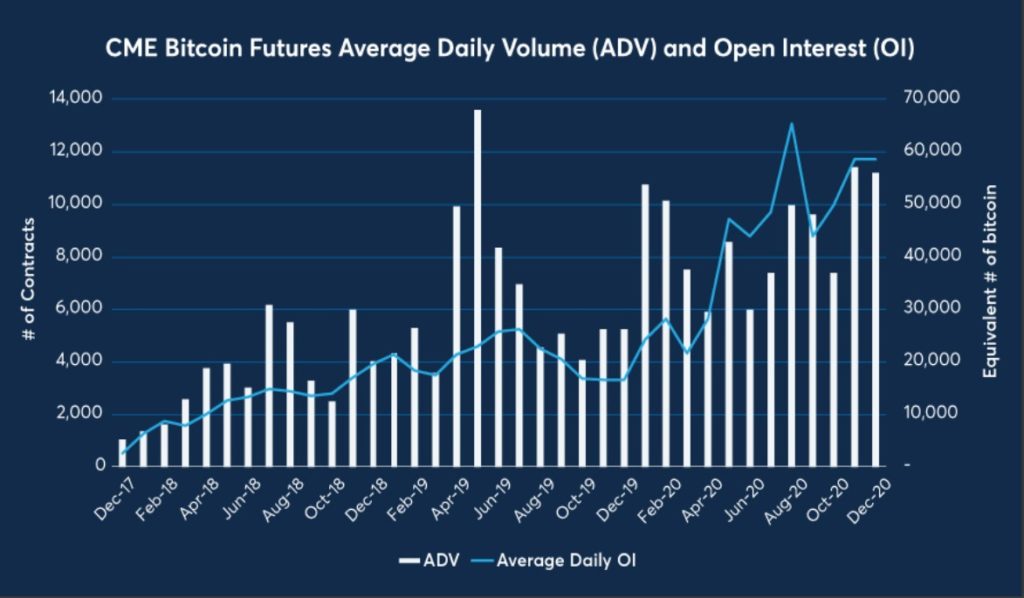
Basically, given all those mentioned arguments it should be more clear to everyone that Bitcoin can not be considered as emerging new global currency next to regular fiat money, that we currently use. Besides Bitcoin, there are also another crypto-currencies like Etherum, Liteon, Dong etc., which were supposed to be used within certain range of users, but most of these have been considered up to now as only an experiment. For instance, a photo-maker KODAK Eastman Corporation announced that it would develop its own crypto-currency (Kodakcoin) and blockchain, which would be used by their retail customers and photo-makers, who could store their pictures in secured way in the block-chain so that any misuse by unauthorized persons would be prevented from.(10)Unlike Bitcoin (and Etherum) however, the other crypto-currencies did not succeed to penetrate the market further, as their platforms have not been developed so much and the wider usage in practice life was rather an atempt, but after the short life the interest faded away.
Law, Regulation and Accounting Issues
Though Bitcoin usage has not been made illegal by any legislation in most jurisdictions and local Regulators from various jurisdictions are taking steps to provide individuals and businesses with rules on how to integrate this new technology with regulated financial system, there is no centralized approach. For years, U.S. accounting rulemakers have rejected calls to write accounting rules for digital assets like Bitcoin, saying too few companies make significant investments in them, resp. holding them for a longer period.
While previously, companies like Overstock Inc. and Microsoft Corp. allowed customers to make payments in cryptocurrency, their practice was that they have turned those received (BTC) into cash. Such transactions usually din’t stay for long on a company’s balance sheet, eliminating thus any financial reporting questions.
But, in case of long-term holding, such crypto-currencies must be considered otherwise. The American Institute of CPAs in December 2019 issued non-binding guidance that cryptocurrency like Bitcoin should be accounted for as intangible assets, in accordance with ASC 350 Intangibles-Goodwill, Other. The panel that wrote the guidance reasoned that cryptocurrency didn’t meet the requirements in U.S. GAAP to be considered a financial instrument or inventory. And here comes the pain for every entity that would consider investing into Bitcoins, because it must record every (negative) impairment of BTC value resulting from its down-wards movement on the market, but any up-wards movement would not be recognized into Equity nor Income Statement (just like with Goodwill). The only moment, when any gains from positive revaluation with crypto-currency holding are incurred into the books, is in case of their sale. Different treatment of crypto-currencies may be allowed with Financial services/ Investment companies, which would account for any digital assets at fair value, thus recognizing any up and down movements in current market value. However, in its recent statement from February 2021, FASB stood by its October decision not to develop new accounting rules for digital assets. (11) Whether this will change with most recent increased interest of corporate world for doing the business in Bitcoins as well, this will yet time tell.
TESLA is Calling
As mentioned at the beginning of the article, there has been quite an epic rise in Bitcoin value during the first months of 2021. As there is a lack of any economic relations, what factors have provided such a big support?

Surprisingly or not, Elon Musk made major call in Jan 2021, when he first tweeted couple of messages about BTC and then, his automotive producer TESLA announced that it had invested free cash of $1.5 billion into this crypto-currency, which they further expect to use in trade relations with suppliers and buyers. Further, TESLA also intends to allow the buyers to pay in Bitcoins, at least in some limited scope. (12) However, this was not the first case, when Elon Musk used his influence within social media and tweeted some messages about any crypto-currency. It had been already analyzed by other professionals, that only within couple of hours after he posted his (positive/negative) tweets, the price of these crypto-currencies goes up or down quite notably. (13)
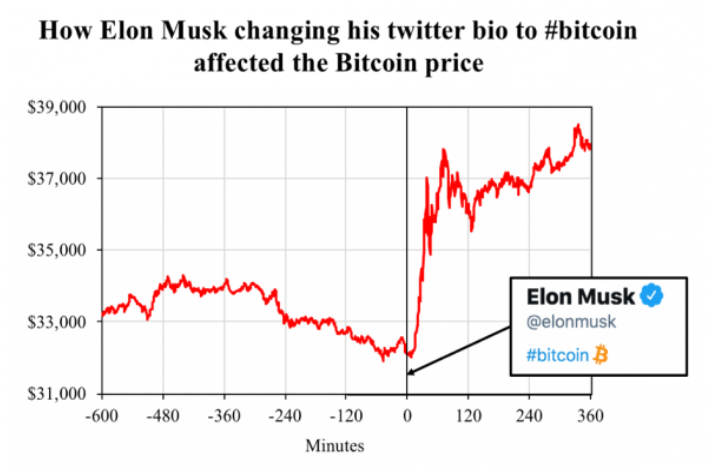
Previously, it was when he was blessing Dogecoin to become “crypto for masses”, which also ignited investors interest into this asset class. (14) So, what could bet he real reasons or motivation for Elon Musk to make such a bold move into highly volatile Bitcoin, when putting at risk such a huge amount? In case of 50% of BTC decrease in value, entire FY19 Annual profit of TESLA would be wiped-out representing substantial impact into Profitability ratios. Even though he did not provide any more detailed explanation so far about the main motivation, lets make here following assumptions, what could have been hypothetical reasons for that:
- When adopting BTC, it could simply boost the sales of TESLA cars, as too much Bitcoins are held by miners (gained as a fee), whereas with increased BTC value it does not costs so much to buy this car (the starting price with smallest TESLA class is currently to be sold for just one Bitcoin). This is simply a peanut expenditure easily affordable by all Bitcoin holders, when compared with very first retail payment done with BTC for a couple of Pizza boxes, which have been paid for with 10,000 Bitcoins by a Florida-based IT guy, some 10 years ago. (15)
- However, TESLA made a signifficant purchase of Bitcoins, which has nothing to do with their sales (under which they would rather receive it), unless they agreed with their suppliers that it could be paid in BTC for deliveries of auto parts, tyres or engines. Nonetheless, this does not seem to be realistic, as the risk of suddenly decreased market value of BTC would be transferred onto these suppliers.
- TESLA made this move, as Elon Musk is a big fan of crypto-currency as he already showed in the past, he has dozens of millions followers on social media and his words can really move the market, as these assets are highly sensitive for such statements. In addition, he was not alone at that time, as another corporations like Paypal and American Express introduced new services connected with Bitcoins. This altogether may represent certain move towards the regulators and supervising bodies like FASB to embrace the digital assets like BTC. Like it was mentioned previously, so far any positive gains do not enter into corporate balance sheet or Equity, but if this was about to change in a near future, company like TESLA could benefit from such a unprecedent bets.
- And quite hypothetically, it may appear as this step was a pure speculation how to earn quickly a nice profit, not really connected with TESLA core business. Something in a sense like “I need a rocket for my….ehm rocket”. As Elon Musk is running also other businesses besides TESLA, and among them there is SPACE-X project, which seems to be of very special importance for Musk, but until now this has been a costs-driven project. So with this speculation, a big pay-check could be delivered for funding the expanding programme outside TESLA, in fact. This was the timeline of the main steps:
- SEC Fillings for period ending 31-Dec 20 disclosed that TESLA had intended to invest around $1.5 billion, whereas the BTC price ranged from USD 19,000 to 29,000 in Dec 2020 period;
- in period Jan-Feb 2021 he made several “clever” tweets about Bitcoin and Doge(coin), but without any further details;
- at the end of Mar 2021 he announced TESLA going to accept BTC in its sales operations, but in limited scope so far;
- SEC Fillings for period ending 31-Mar 2021 revealed the realised gains from sale of BTC around $128 Million, while the unrealised gains from held crypto-currency made $ 1.15 billion – for details please refer to below attached Quarterly results, section “Digital assets”;
- during the 1st week of April 2021, when BTC peeked around USD 63,300 investment of $1.5 billion could potentially earn total gains around $2 billion in just 3-4 Months depending on purchase price (compared with TESLA Annual profit of “just” $0.7 billion in 2020); whether these digital assets were sold or not during 2Q2021 this is to be found-out from upcoming SEC Fillings, which is due to be published in July (an update on that will be provided);
- on April, the 12-th, a crypto-exchange Binance (in partnership with CM Equity AG and Digital Assets AG platform) has announced to be launching a new zero-commission tradable stock tokens, while the first listed company will be unsurprisingly TESLA; (16)
- on April, the 14-th SpaceX private company informed that had succesfully raised $1.16 billion for new contract with NASA, which was officially won by Elon Musk on April, the 17-th, about building a lunar landing system to ferry astronauts to the surface of the moon. SpaceX will receive for this activity almost $3 billion. (17)

If all above mentioned was only a coincidence, then Ellon Musk has demonstrated perfect sense how to time the market, at least.
Update: In July 2022 TESLA published in its Interim report for 2Q22 that it had sold almost 75% of its previous BTC holding coming down to USD 218 Mio from USD 1,26bln (estimated selling price around USD 29,000). First sale of digital assets took place in 2Q21, whereas it has trimmed its initial position by 10% for an income of USD 272Mio. The Company of Elon Musk has never reported any cars sold for Bitcoins, Elon Musk himself cited concerns about ecological aspect of mining this digital currency being the main reason for temporarily terminating the Bitcoins acceptance, until situation changes. 24
B like a Bubble?
Naturally, as a result of rapid rise in the value during the last Months, all conversations around Bitcoin were finger-pointing at next possible Bubble on market. Lets have a look, how is a market bubble defined by its home-page Bitcoin.org:
“A fast rise in price does not constitute a bubble. An artificial over-valuation that will lead to a sudden downward correction constitutes a bubble.”
Whether it is true or not, only time will tell. In widelly published analysis, current market “hype” for BTC was associated with Dot.com Bubble (18), which happened some 20 years ago, when the spiking stock prices were not logically valued based on the performance of their companies, that were mostly just the promise for future business contribution but without underlying sound concept in place. Here we can see some difference, as the over-valued stocks that simply can not deliver any reasonable Dividends are useless for their investors to hold anymore.
When it comes to crypto-currencies, even when their price oscilate in time, they can be perceived like a valuable long-term assets (equivalent of gold bullions etc.), so that when some investors dump them another can use the opportunity to buy them for a cheap, accumulate and hold for a future sale. Besides speculation trades, there are still running real purchases and sales in the business for Bitcoins, and total turn-over is growing. And lastly, what seems quite useful for a real business, is at least block-chain concept, which has proven to be secure for recording the multiple information in a chain.
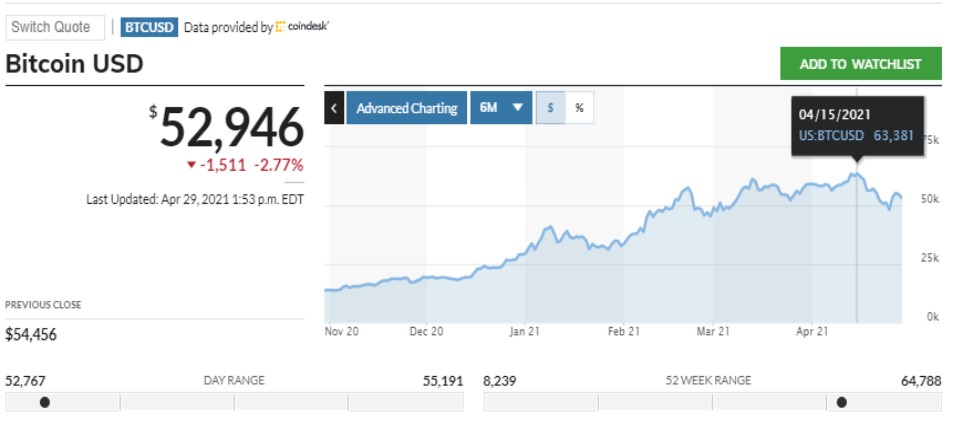
Conclusion (so far…)
What is clear right now, is that any future development of BTC price may go both directions, i.e. up and down-wards. After having reached top level around USD 66,000 there were some negative news that have caused interim correction and sent the price around USD 55,000 at the end of Apr-2021 (i.e. down by 20%). Among such news, was announcement of Turkey and India that they had banned this crypto-currency from usage in their countries (19). On the contrary, if any positive news like adoption of a wider rules by main regulators or larger investments by Hedge Funds for instance will pop-up in a near future, these will act like a catalyst for further growth. This is the most likely market trajectory, in which Bitcoin is going to move in a future.
Further, there is also connected higher energy consumption with these mining activities, which make the investments into BTC not really compliant with ESG (Environmental Social and Governance) investments principles, which are clearly becoming main drivers for investors. According to the University of Cambridge’s bitcoin electricity consumption index, bitcoin miners are expected to consume roughly 130 Terawatt-hours of energy (TWh), which is roughly 0.6% of global electricity consumption. (20) This aspect may become soon a decisive factor whether such extensive mining activities will be tolerated, under circuimstance that whole world is trying to reduce its carbon footprint.
What has not been yet laid-out clearly, is that Bitcoin is not very suitable investment for unexperienced retail investors due to its very high volatility and very bad predictability of future evolution. These retail investors very often try to catch the market trends, when they have already matured and actually reverse trends are starting to roll-in. In such situation these investors tend to panick more and may spark the market sell-off in their over-reaction. So, who is actually owning the majority of Bitcoins, nowadays? For such question, it has been never easy to find exact answer.
First, Bitcoin holding is anonymous given no bank statements and only electronic key being sufficient to have access to it, which also gives quite a good opprotunity for money laundering activities (i.e. to circulate the money without a risk of being tracked), which is pretty often a subject to massive criticism. But, lets just assume that more than 50% of all Bitcoins is widelly held by individuals incl. Retail investors, Miners and other private persons.
Further, there are institutional investors who have been continuously building-up their position in digital currency like BTC and consider it as long-run investment opportunity. According to Bitcointreasuries web page, among the largest holders of Bitcoin, there can be following entities:
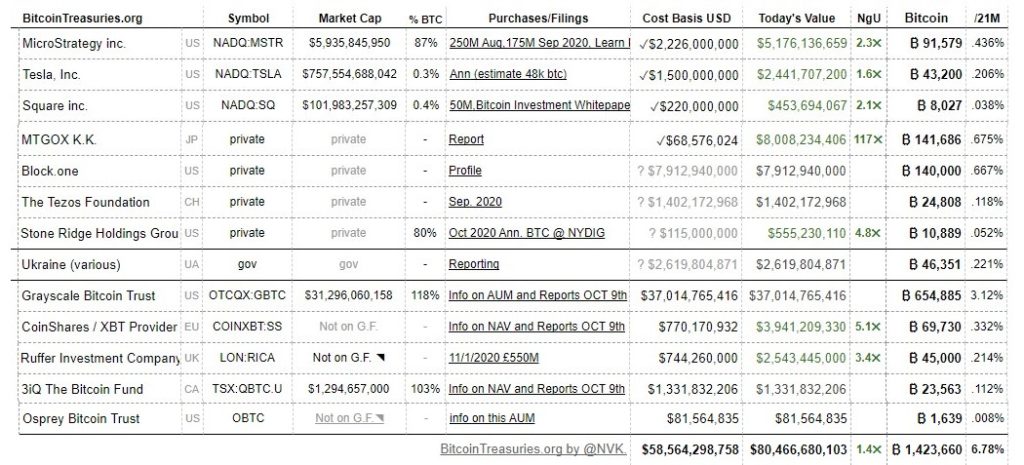
the main selection listed only
What is quite clear from this overview, the largest single institutional holder is Greyscale Bitcoin Trust (“GBTC” Nasdaq Ticker) with almost 655 tsd. of Bitcoins making an share of more than 45% on total Institutional holding (more than 1,4 million units). Greyscale is a financial trust vehicle that allows wealthy investors to have exposure towards various crypto-currencies. The minimun investment was set at USD 50,000 but there is also a possibility to buy its shares, which are listed on Stock-exchange. Nowadays, GBTC holds 13 Trusts with total assets worth around USD 45 billions, thereof only Bitcoin Trust made USD 37 billions. Its position on the market de-facto replaces missing Exchange Traded Funds (ETF) for Bitcoins and other digital assets, which makes it the largest based on market capitalisation. (21) It is quite interesting to remind that US Stock Exchange (SEC) regulator has denied for several times appeals to approve Bitcoin ETFs from reasons that BTC value can be manipulated. However, Greyscale has stated its target for current season to get the license for ETF Fund.
Among other largest BTC holders there are some American and Japanese-based private entities with individual worth around USD 8 billions each, and followerd by MicroStrategy enterprise with crypto-currency investment above USD 5 billions (being close to market capitalisation of the company, itself).
Quite interesting thing is also the evidence of some 46 tsd. of BTCs held by various Ukraine government entities and officials in total value around USD 2.6 billions. According to other sources (Opendatabot reports) these Bitcoins are held by official representatives of District councils, Ministry of Defense and National Police.(22) Well, this may be also the reason why Ukraine is trying to embrace digital assets more than other EU countries in order to put them into real life and business. However, The Financial Action Task Force’s 2019 directive for monitoring crypto transactions added some urgency to the need for crypto regulation. The intergovernmental watchdog asked countries to implement stringent KYC rules for crypto exchanges and transactions. There is also potential down-side in any shortages for countries that fall out of compliance with FATF’s recommendations that are risking being put on a blacklist, meaning they might lose some access to the global financial markets. (23)
And lastly, we should not forget to mention Bitcoin founder, Mr. Nakamoto, who is also claimed that had secured for himself some 10 millions Bitcoins, before he totally vanished from the scene. Although this is hard to believe to be true, it may be the same hard to verify. Nevertheless, there are no records available for such rumours. Well, then only around three millions of Bitcoins were left to be yet available, which have probably caused the abnormal interest of new miners, as they still represent very valuable property worth around USD 150-160 billions (depending on current price) that will be subject to increased competition. What happens when all Bitcoins find its new owners is a big mystery and we will have to wait how the new equilibrium for Bitcoins will look like. Until then, the party does not stop and music is to play.
Note: the author of this article is not anyhow exposed to Bitcoin or another crypto-currency and this is not intended as financial advise how to invest into Bitcoin and other digital assets.
References and Sources: 1/ BTCUSD-Bitcoin-USD-Overview-MarketWatch 2/ www.wikipedia.org/wiki/Satoshi_Nakamoto 3/ https://procureconindirecteu.wbresearch.com 4/ Best Bitcoin Trading Platform 2021 – Cheapest Platform Revealed (tradingplatforms.com) 5/ www.Coinbase.com; Coinbase’s IPO Gets Pushed To April | PYMNTS.com 6/ www.bloomberg.com 7/ www. en.wikipedia.org/wiki/Blockchain 8/ www.bitcoin.org 9/ BitRiver Is Selling Tokens to Build More Bitcoin Mining Farms in Siberia (yahoo.com) 10/ CES 2018: Kodak soars on KodakCoin and Bitcoin mining plans – BBC News 11/ Tesla Bitcoin Bet Exposes Limits of Crypto Accounting Rules (bloomberglaw.com) 12/ Tesla buys $1.5 billion in bitcoin, plans to accept it as payment (cnbc.com) 13/ The “Musk Effect” – How Elon Musk’s tweets affect the cryptocurrency market – Blockchain Research Lab 14/ Causal effect of Elon Musk tweets on Dogecoin price | Fabian Dablander 15/ Bitcoin Surge Means Laszlo Hanyecz Paid $613 Million for Two Pizzas (businessinsider.com) 16/ Binance Launches Stock Tokens, Starting With Tesla (yahoo.com) 17/ SpaceX Wins NASA $2.9 Billion Contract to Build Moon Lander – The New York Times (nytimes.com) 18/ Bitcoin is a bubble, say 74% of Bank of America survey respondents (cnbc.com) 19/ Bitcoin falls as Turkey bans cryptocurrency payments – MarketWatch; India to propose cryptocurrency ban, penalising miners, traders – source | Reuters 20/ The debate about cryptocurrency and energy consumption | TechCrunch 21/ GBTC: Everything You Need To Know About The Grayscale Bitcoin Trust – Decrypt 22/ Ukraine’s Civil Servants Report Owning $2.6 Billion Of Bitcoin | Nasdaq 23/ Why Ukraine Is Ripe for Cryptocurrency Adoption – CoinDesk 24/ www.coindesk.com